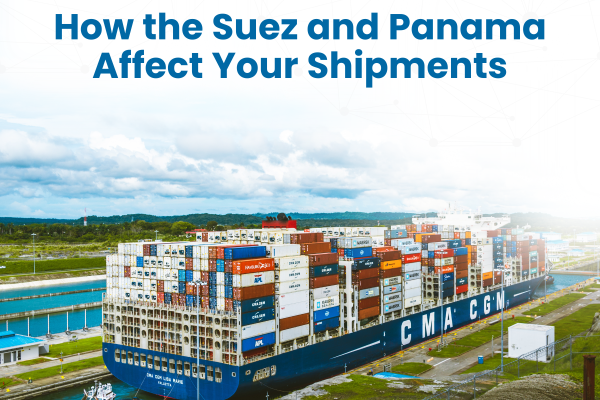Importers and exporters who have shipments to/from Europe, or to/from the USA, will be wondering how current geopolitical events affect their freight costs and transit times.
2025 was always going to be a highly unpredictable year in container shipping, but current events in both the Suez Canal and the Panama Canal, combined with historical incidents at those two chokepoints, are cause for concern among shippers.
Around 6% of global maritime trade passes through the Panama Canal, while the Suez Canal accounts for another 12% of global trade, including several million tonnes of cargo to and from Australia annually.
Readers will recall the panic when the Suez Canal was blocked by the containership Ever Given four years ago. Together, the Suez and Panama Canals form vital arteries in the movement of cargo vessels around the globe.
THE PANAMA CANAL
For the past two years, a severe drought has forced the Panama Canal to reduce shipping traffic. Authorities have limited the number of cargo ships in the canal due to a lack of rainfall that has depleted the water reserves of two artificial lakes supplying the vital waterway.
According to the treaty with the autonomous Panama Canal Authority (PCA), fees for passage of vessels must be “just, reasonable, equitable, and consistent with international law.” In recent years, fees have increased, and while they are largely in line with the Suez Canal, auctions to enter the canal can significantly bump up the total transit fees.
Donald Trump has declared the USA will take back control of the Panama Canal, saying its revenues are “ridiculous and highly unfair.” He added, “And above all China is operating the Panama Canal and we didn’t give it to China, we gave it to Panama, and we’re taking it back.”
The PCA is planning to build a tunnel from a river to the west of the Canal to a dam to feed the Gatun Lake as a long-term solution to avoid the lack of water. Also, the Canal Authority aims to become net-zero by 2050. Construction may start in 2025/2026 and is slated to take five/six years. Until then they still have to rely on rain, but 2025 is looking better in this respect. We’ll have a better idea in the next six months regarding 2026.
THE SUEZ CANAL
Since the Houthis have been targeting cargo vessels in the Red Sea and Suez Canal, most of the major containership operators have been diverting their sailings around Africa. This adds distance, time and cost to your shipments.
Following the start of a ceasefire deal between Israel and Hamas that started 19 January, the Yemini militia Houthis swiftly issued a statement saying it would stop attacks on all non-Israeli-linked commercial shipping.
In the same message they warned that attacks, or “sanctions” as they call them, would be re-instated “in the event of any aggression against the Republic of Yemen by the United States of America, the United Kingdom or the usurping Israeli entity.”
Since the Houthis started their campaign of terror on commercial shipping in November 2023 over 100 vessels have been attacked, two ships have been sunk, four seafarers killed and the 25 crew of the car carrier Galaxy Leader taken hostage. Transits of the Suez Canal have plummeted as the majority of shipping lines opted to re-route via the Cape of Good Hope rather than pay the Houthis for safe passage or arrange naval escort from a supporting government.
Leading maritime researcher Drewry says, “Do not expect container lines to immediately return to Suez Canal transits after the Houthis say they will stop attacks on shipping. The return of Donald Trump is another wildcard for the market in a highly unpredictable year.”
In Drewry’s view, most carriers will wait to see how things develop and will need to be utterly convinced that the threat of attack has been eliminated before they consider a return to trans Suez transits. This timeline would take months rather than weeks.
Once carriers deem Suez to be a safe option, the hope is that shipping to and from Europe will gradually return to more acceptable times, although there is no prediction of rates coming down.
Here at Colless Young, we keep up to date on shipping movements at critical ‘chokepoints’ such as the Suez and Panama. Talk to us about the effects on your transit times and freight rates.
Contact Andrew, email enq@collessyoung.com.au Tel: +61 7 3890 0800.

